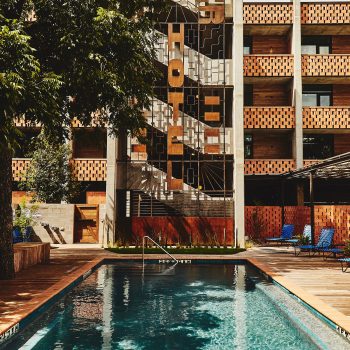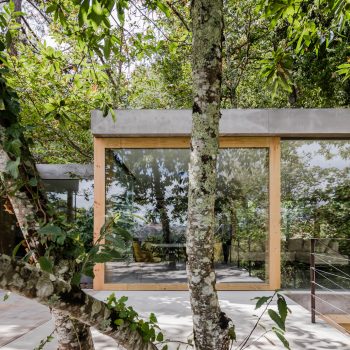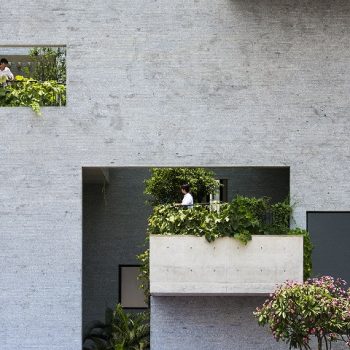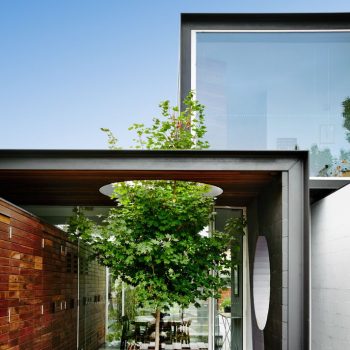 The new Paris Hoxton Hotel has opened in the historic 2nd arrondissement; taking up residence in an 18th century hotel particulier in Rue du Sentier, an historic textile area. The boutique hotel is housed in a building originally designed by architect Nicolas d’Orbay for the diplomat to Louis XV (1710 – 1774) Etienne Rivié. It has been classified as a monument historique (as is the Louvre and Notre Dame) by the French authorities. Prior to the Hoxton group of hotels acquiring the building, it laid waste for over a decade after operating as a clothing factory during the 20th century. The refurbishment has taken four years and it has been worth the wait.
The new Paris Hoxton Hotel has opened in the historic 2nd arrondissement; taking up residence in an 18th century hotel particulier in Rue du Sentier, an historic textile area. The boutique hotel is housed in a building originally designed by architect Nicolas d’Orbay for the diplomat to Louis XV (1710 – 1774) Etienne Rivié. It has been classified as a monument historique (as is the Louvre and Notre Dame) by the French authorities. Prior to the Hoxton group of hotels acquiring the building, it laid waste for over a decade after operating as a clothing factory during the 20th century. The refurbishment has taken four years and it has been worth the wait.
As a building of some note many of the original features have been left exposed or restored. Nicolas Pineau, a leading 18th century carver and sculptor was responsible for some of the buildings most ornate and impressive features.
 The splendid original façade from the high Rococo period has been fully restored in addition to two of the original grand staircases, while 18th century tiles on site have been appropriated for use as a mosaic in the bar area.
The splendid original façade from the high Rococo period has been fully restored in addition to two of the original grand staircases, while 18th century tiles on site have been appropriated for use as a mosaic in the bar area.
As the concept suggests, a boutique hotel is ideally suited to the original architecture and its Paris location.
Carefully curated interiors by Humbert and Poyet invoke a stylish mix of late 19th century with mid-century furnishings. As an 18th century building the towering ceilings add to the grandeur of the rooms. This feature has been enhanced by detailed cornicing, panelling and reclaimed chevron oak flooring. If we wanted to ascribe a stylistic link to the 18th century it would be to a blend of the Rococo period which fed into Neo-classicism. While the Rococo is known for the overt frivolous style of Marie Antoinette (extravagant curliques and shell-like motifs dominating) the use of romantic yet strong pastel shades throughout at the Hoxton has a lot in common with a mix of both periods.
Spacious rooms, with velvet sofas and chandeliers add to a glamorous and sophisticated experience merging a strong sense of history with present trends in interior design.
 Like fashion, generally interior design in the 21st century tends to the eclectic and being so, adds to the charm of the Hoxton’s reinvention as a stylish boutique hotel. The skeleton and history of the building impart architectural authority in advance of anything having been reimagined; as a wreck it would have been stunning. Interestingly, it is almost as if Humbert and Poyet took their palette selection from the work of 18th – 19th French Neo-classical painter Jacques Louis David.
Like fashion, generally interior design in the 21st century tends to the eclectic and being so, adds to the charm of the Hoxton’s reinvention as a stylish boutique hotel. The skeleton and history of the building impart architectural authority in advance of anything having been reimagined; as a wreck it would have been stunning. Interestingly, it is almost as if Humbert and Poyet took their palette selection from the work of 18th – 19th French Neo-classical painter Jacques Louis David.
Taken as a whole, the quality interiors prescribed by the designers assume the same high standards the building itself demands.
David’s beautiful Oath of the Horatii (1784) in the collection of the Toledo Museum of Art, has all the colours covered in the furnishings of the hotel. In contrast to Marie Antoinette’s Rococo extravagance, Neo-classicism is more masculine, vertical and horizontal, in style.
In and around Hotel Hoxton are the many historic covered arcades the 2nd arrondissement is known for, as well as the shortest street in Paris the quaint Rue de Degres: while the Centre Pompidou and the Rue Montorgueil, which is one of the oldest market streets in the centre of Paris with food of every known manifestation, are also within walking distance.
It is almost impossible to think of waking up in such beautiful surroundings within such an expansive and stimulating atmosphere, where every detail has been designed to bring joy to the Hoxton’s visitors; leaving this boutique hotel at the end of the holiday would be a difficult decision indeed.
CENTRE POMPIDOU:
ANDRÉ DERAIN 1904 – 1914 LA DÉCENNIE RADICALE
Currently, the Pompidou is showing an exhibition by Andre Derain (1880 – 1954) a prominent member of the Fauvist’s in the second decade of the 20th century.
 He was persuaded after meeting Matisse to become a painter, and not surprisingly he favoured bright colour in the manner of Matisse showing a debt to Pointillism in his application of paint. As Fauvism abated he became more traditionalist, evolving a style of landscape based on browns and olive greens. “The Centre Pompidou is presenting André Derain 1904 – 1914. La décennie radicale (The Radical Decade), which takes a fresh look at the work of this major 20th century artist, tracing the various stages of his career before the First World War, when he was involved in the most radical avant-garde movements. Some remarkable groups of work have been brought together for the exhibition: his 1905 summer pieces painted in Collioure; a series of London scenes, and his very large dance and bather compositions.”
He was persuaded after meeting Matisse to become a painter, and not surprisingly he favoured bright colour in the manner of Matisse showing a debt to Pointillism in his application of paint. As Fauvism abated he became more traditionalist, evolving a style of landscape based on browns and olive greens. “The Centre Pompidou is presenting André Derain 1904 – 1914. La décennie radicale (The Radical Decade), which takes a fresh look at the work of this major 20th century artist, tracing the various stages of his career before the First World War, when he was involved in the most radical avant-garde movements. Some remarkable groups of work have been brought together for the exhibition: his 1905 summer pieces painted in Collioure; a series of London scenes, and his very large dance and bather compositions.”
L’oeil écoute “Once a year a new sequence of dossier exhibitions set among the display of the permanent collection offers visitors a fresh glance at the history of 20th-century art by focusing on a specific theme. Occupying vitrines, passages and rooms, these study displays cast light on hidden aspects of modern art: after a sequence devoted to the great communicators, the historians, critics and enlightened art-lovers who contributed so much to writing its history, and another devoted to the politics of art, looking at artists’ engagement with the great ideologies of the 20th century, the museum today highlights the connections that existed between music and the visual arts from 1905 to the mid-1960s.“
THE MODERN COLLECTION (FROM 1905 TO THE 1960’S)
 “The modern collection consists of over 7 000 works in the field of the visual arts (paintings, sculptures and objects) produced by 1,535 artists born before 1920, together with over 800 anonymous works in the realm of tribal arts. These works are exhibited on the fifth floor of the permanent collections in rotation, in a circuit that starts chronologically at the beginning of the 20th century with the Fauve revolution.”
“The modern collection consists of over 7 000 works in the field of the visual arts (paintings, sculptures and objects) produced by 1,535 artists born before 1920, together with over 800 anonymous works in the realm of tribal arts. These works are exhibited on the fifth floor of the permanent collections in rotation, in a circuit that starts chronologically at the beginning of the 20th century with the Fauve revolution.”































